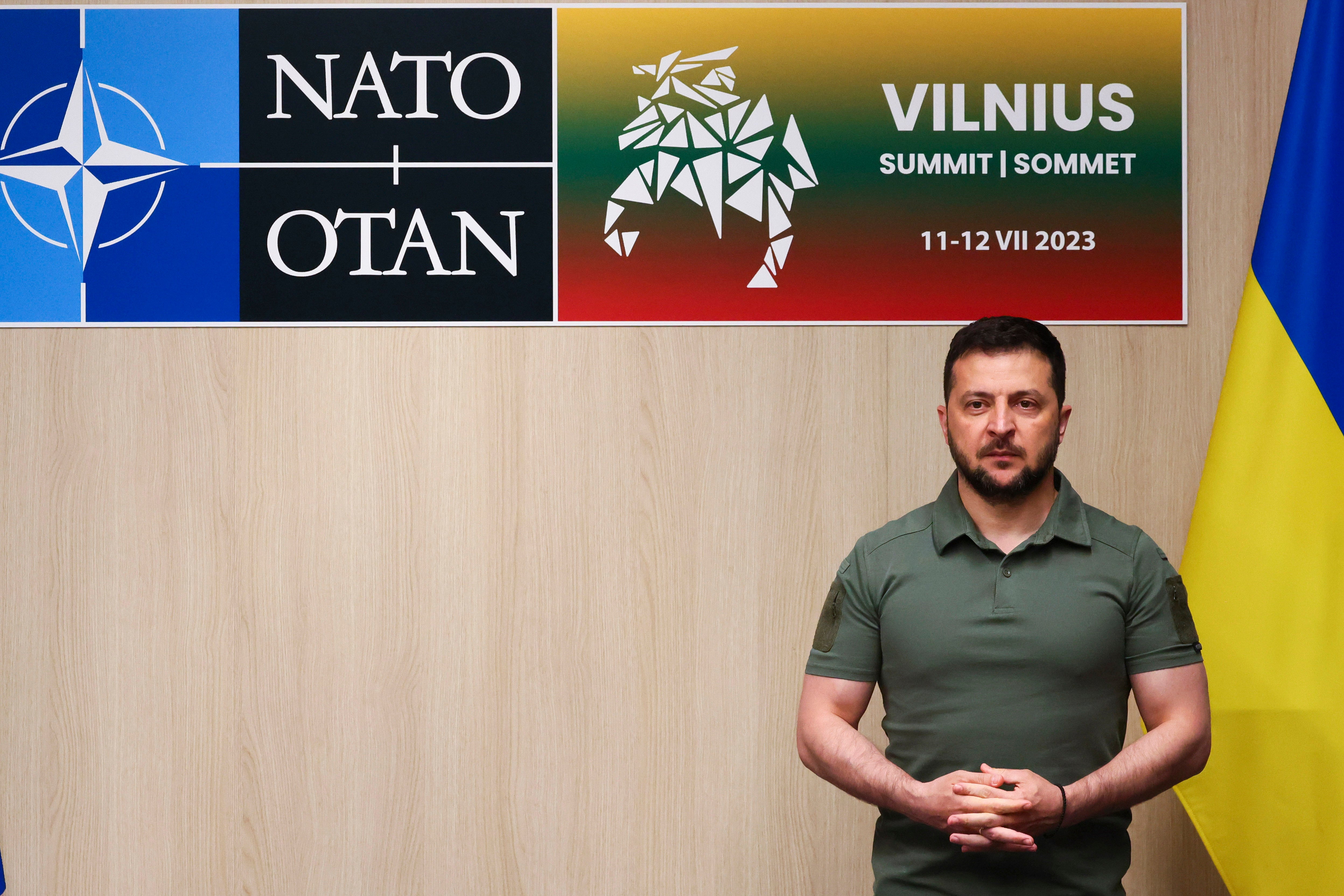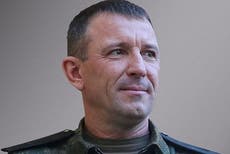The Nato summit was not the triumph that Zelensky hoped it would be
The Ukraine president found his efforts to join the bloc frustrated, writes Mary Dejevsky. But the event did have its uses


When they met for their summit in Vilnius this week, Nato leaders appeared to have just one item left on their agenda – how, when, and even whether to admit Ukraine.
Advance discussions had ensured that before anyone even arrived in Lithuania, the US had agreed to supply F-16 warplanes to Turkey, Turkey had lifted its block on Sweden’s membership, and everyone had agreed to keep the current secretary general for another year. Ukraine would be front and central, and President Zelensky was there in person, with his wife, to claim the honours.
Except that Ukraine was not in fact the only, or even the main, item on Nato’s agenda. The bigger, but unstated, question was how to stand by Ukraine while avoiding a war between Nato and Russia. So much was admitted by the US national security adviser, Jake Sullivan, who told CNN afterwards that if Ukraine were admitted to the alliance now, Nato’s famous mutual defence clause would oblige members to join a direct war with Russia.
Now this might be a slight exaggeration. Article 5 – which stipulates that an armed attack on one member is treated as an attack on all – requires allies to take the action they deem necessary, rather than embark at once on an all-out war. But the fact is there was no consensus in favour of fast-tracked membership for Ukraine at Vilnius, and Russia’s possible response may have been one reason why. Zelensky left Lithuania a disappointed man.
Nato drafters did their best to find reassuring formulations, but Zelensky had to be content with an assurance that Ukraine would indeed join the alliance at some unspecified time in the future, with the customary Membership Action Plan waived. In almost every other respect, the promises fell far short of what Ukraine had hoped for. After listing all sorts of requirements, the Vilnius communique said only: “We will be in a position to extend an invitation to Ukraine to join the Alliance when Allies agree and conditions are met.”
There was no definite timescale, certainly no fast track, and above all no invitation. A new forum was set up, called the Nato-Ukraine Council, which sounded unnervingly similar to the doomed Nato-Russia Council of 2002, which Russia always complained was an institution of unequals. Ukraine received promises of more military supplies, more training and other types of support, all of which was helpful, of course, but not what Kyiv had set its sights on.
Indeed, Zelensky’s first glimpse of the communique had elicited some very un-Zelensky-like fury – he called the lack of a timeframe “absurd” and lambasted the alliance for “uncertainty”, which he said amounted to “weakness”. By the end of the summit, he appeared to have been mollified somewhat, thanks in part to a one-on-one meeting with the US president that went on far longer than planned.
But discord remained, with remarks from US officials and the UK defence secretary about a supposed lack of gratitude on Ukraine’s part. The prime minister, Rishi Sunak, tried to spin the remarks away, but the residue lingered. It was hard not to imagine Zelensky pining for the days of Boris Johnson.
Nor was the explanation for what Kyiv will have seen as an unsatisfactory outcome hard to divine. For all the visual and verbal focus on Ukraine at Vilnius, the communique tells a rather different story. For every mention of Ukraine, there are many more mentions of Russia, with the opening to paragraph 19, perhaps key: “We seek stability and predictability in the Euro-Atlantic area and between Nato and Russia. Nato does not seek confrontation and poses no threat to Russia ... We remain willing to keep open channels of communication with Moscow to manage and mitigate risks, prevent escalation, and increase transparency...”
The imperative to avoid a war between Nato and Russia is a thread that runs through the Vilnius proceedings, to which alliance support for Ukraine – Zelensky will be unhappy to know – comes second. Until this point in the war, this consideration has rather lurked in the background, with some blurring of the lines. No longer.
Moscow has long been of the view that the war in Ukraine is essentially a proxy war between Russia and Nato. And it would not be completely wrong. Nato members are supplying Ukraine with military assistance, intelligence and training in many cases to Nato standards. But there is a big difference between a proxy war and a direct war and, while some Nato countries have seemed almost to welcome the prospect of a conflict between the alliance and Russia, the United States in particular has been at pains to ensure that the one does not become the other.
Since the 2022 Russian invasion, Western military and other help for Ukraine has been supplied on a strictly bilateral, country-to-country basis. One of the reasons why the US rebuffed Ukraine’s early pleas for a no-fly zone was that it would imply alliance involvement.
Contrary to the impression often given, the US has also kept communications channels open and acted quickly to preempt certain misunderstandings. In November, it earned Moscow’s thanks by confirming that a missile landing in Poland was not Russian, but a misfired anti-aircraft rocket from Ukraine. Last month, as speculation swirled about Yevgeny Prigozhin’s mutiny, the CIA director called his Russian counterpart to assure him that the US was not involved.
And reports recently emerged of at least one – maybe more – secret meeting between veteran US Russia-watchers, Russians with links to the Kremlin, and the Russian foreign minister, Sergei Lavrov. This was the first hint that any so-called “track-2” diplomatic activity might be in train. It angered Ukraine, as it suggested talks were taking place behind its back, but fostered hope elsewhere that diplomacy was not dead.
Efforts to maintain a rigorous separation between Nato and any increased help for Ukraine were also apparent at Vilnius in the somewhat unusual structure of the meetings and participation. The Nato summit was supplemented by something akin to a G7 mini-summit, and it was the G7 – although not a security grouping – that provided the security guarantees and other assistance for Ukraine.
There are only two possible reasons for this: to signal that support for Ukraine goes beyond the US-Europe alliance (although the only addition here was Japan); more particularly, though, to keep Nato, as a military alliance, formally at arm’s length from the defence of Ukraine. Support from the G7, as an economic and civilian grouping, could not be seen by Russia as increasing any risk of war.
For Nato to co-opt the G7 in this way, however, has a downside. The G7 is the club of the world’s richest nations. If there has been any failure of the West in mustering support for Ukraine and isolating Russia, it has been in the so-called “global South”. Despite efforts to broaden support by, for instance, presenting the conflict as a war for national liberation against an imperial power, there is scant evidence this is having much effect. Geography and economics are more persuasive arguments.
The consolation, if there is any, from the Vilnius summit should be that Nato – steered perhaps by a US president seeking re-election – is at least trying to avoid the Ukraine conflict spiralling into a wider war. This may not provide much reassurance to an already war-ravaged Ukraine, but it could offer a sliver of hope to the rest of Europe and the wider world that the war can be contained.
Join our commenting forum
Join thought-provoking conversations, follow other Independent readers and see their replies
Comments


Bookmark popover
Removed from bookmarks